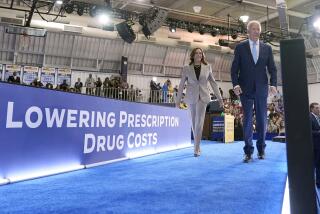Drugs Pricier for Seniors, Government Study Shows
- Share via
WASHINGTON — Nearly half of all older Americans have no coverage for prescription drugs and they pay at least 15% more for the medications they do buy, according to a government study to be released today by President Clinton.
And many of the senior citizens may pay significantly more than that, according to the study, the government’s first detailed drug-pricing study in a decade.
Although it has long been clear that those without insurance pay more for their prescriptions than those who have coverage, the study highlights that coverage also carries with it the benefit of significant drug company discounts and rebates, as much as an additional 35%.
The majority of older Americans without drug coverage have incomes below $17,000 a year, but even among those with higher incomes--as much as $45,000 a year for a couple--nearly 25% lack coverage.
The problem is worsening as more companies drop their retiree drug plans and the cost of drugs continues to skyrocket, the study found. Drug prices rose more than twice as rapidly as other health care costs from 1993 to 1998--12% annually compared to other medical expenditures, which had an average annual growth rate of 5%.
The new information, while hardly surprising, is likely to sharpen the debate on Capitol Hill and on the campaign trail over how to design a prescription drug benefit for seniors.
The issue has become increasingly high profile in Congress as lawmakers complete their work on the 2001 budget and House Republicans expect to offer a drug-coverage plan for seniors, perhaps as early as this week. Their plan is likely to focus on subsidizing coverage for lower-income seniors and encouraging the insurance industry to provide more drug coverage for other seniors.
Clinton, who requested the study, plans to use the data to underscore the need for the speedy passage of his plan, which, when fully phased in, would pay up to 50% of the first $5,000 in drug bills for all seniors, regardless of income, and includes additional coverage for those whose drug costs are extremely high.
“The study furthers our case for a voluntary prescription drug benefit that is available to all beneficiaries,” said a senior White House official, adding that Clinton plans to keep hammering on the drug coverage issue for the remainder of his term in office.
Clinton also will call today for a conference this summer on drug pricing to continue efforts to broaden understanding of how drugs are priced and specifically of rebate arrangements.
Representatives of the insurance industry and drug manufacturers said the study appeared thorough, and they agreed generally with the problems it highlights. However, they differ deeply with the White House on how to provide coverage for seniors who lack it.
“Clearly the study shows that the area is complex and that many elderly need some kind of assistance to buy their drugs by anybody’s definition,” said Chip Kahn, president of the Health Insurance Industry Assn. of America.
“The problem Congress has is that this isn’t the best political environment to settle an issue like this, and Republicans and Democrats aren’t going to agree about how to make that happen . . . and so it will be taken to the polls in November.”
Alan Holmer, president of the Pharmaceutical Manufacturers of America, took a harder line because the drug industry is inalterably opposed to any government regulation of drug prices. “Expanded drug coverage is the answer, but the president’s plan is the wrong solution,” said Holmer. “Seniors need to be able to choose the private insurance plan that’s best for them--not a big-government, one-size-fits-all scheme,” Holmer said.
The study, which is more than 200 pages long, outlines the enormous complexities in how prescription drugs are priced. Cost depends on the buyer, the volume of the drug bought and on the arrangement between the drug company and the pharmacy benefit manager--the companies that coordinate the transaction between the drug company, the insurer and the pharmacy where the consumer buys the drug.
Rebates given by drug manufacturers reduce the total amount paid by the insurer or the pharmacy benefit manager. However, it remains unclear whether those savings are passed on to the consumer directly through lower drug prices or indirectly, through a more inclusive insurance benefit. Alternatively, the savings may go to improve the profit margins of the insurer, HMO or pharmacy benefit manager.
The effort to investigate drug pricing started more than a year ago when Rep. Henry A. Waxman (D-Los Angeles) began surveying pharmacies on behalf of other members of Congress to provide data on the price differentials for insured and uninsured seniors.
“The pricing system for drugs is broken. Seniors who can pay the least but need drugs the most pay the highest prices. Congress must act now,” said Waxman.
The studies have been wildly popular with Democrats, 115 of whom have asked Waxman’s staff to do such surveys for their congressional districts.
More to Read
Sign up for Essential California
The most important California stories and recommendations in your inbox every morning.
You may occasionally receive promotional content from the Los Angeles Times.












